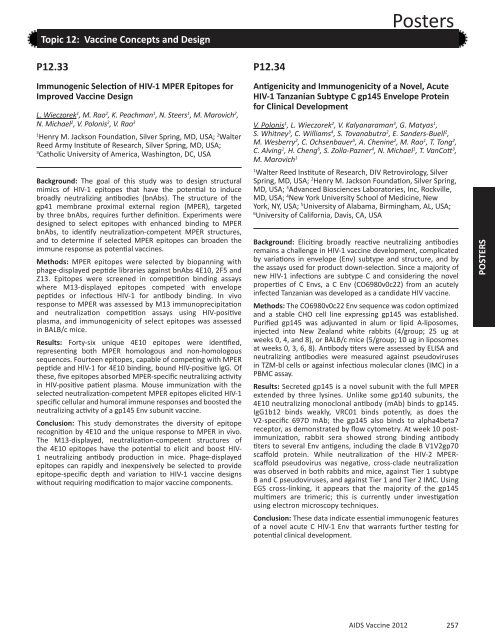Oral Abstract Session 01 - Global HIV Vaccine Enterprise
Oral Abstract Session 01 - Global HIV Vaccine Enterprise
Oral Abstract Session 01 - Global HIV Vaccine Enterprise
You also want an ePaper? Increase the reach of your titles
YUMPU automatically turns print PDFs into web optimized ePapers that Google loves.
Topic 12: <strong>Vaccine</strong> Concepts and Design<br />
P12.33<br />
Immunogenic Selection of <strong>HIV</strong>-1 MPER Epitopes for<br />
Improved <strong>Vaccine</strong> Design<br />
L. Wieczorek 1 , M. Rao 2 , K. Peachman 1 , N. Steers 1 , M. Marovich 2 ,<br />
N. Michael 2 , V. Polonis 2 , V. Rao 3<br />
1 Henry M. Jackson Foundation, Silver Spring, MD, USA; 2 Walter<br />
Reed Army Institute of Research, Silver Spring, MD, USA;<br />
3 Catholic University of America, Washington, DC, USA<br />
Background: The goal of this study was to design structural<br />
mimics of <strong>HIV</strong>-1 epitopes that have the potential to induce<br />
broadly neutralizing antibodies (bnAbs). The structure of the<br />
gp41 membrane proximal external region (MPER), targeted<br />
by three bnAbs, requires further definition. Experiments were<br />
designed to select epitopes with enhanced binding to MPER<br />
bnAbs, to identify neutralization-competent MPER structures,<br />
and to determine if selected MPER epitopes can broaden the<br />
immune response as potential vaccines.<br />
Methods: MPER epitopes were selected by biopanning with<br />
phage-displayed peptide libraries against bnAbs 4E10, 2F5 and<br />
Z13. Epitopes were screened in competition binding assays<br />
where M13-displayed epitopes competed with envelope<br />
peptides or infectious <strong>HIV</strong>-1 for antibody binding. In vivo<br />
response to MPER was assessed by M13 immunoprecipitation<br />
and neutralization competition assays using <strong>HIV</strong>-positive<br />
plasma, and immunogenicity of select epitopes was assessed<br />
in BALB/c mice.<br />
Results: Forty-six unique 4E10 epitopes were identified,<br />
representing both MPER homologous and non-homologous<br />
sequences. Fourteen epitopes, capable of competing with MPER<br />
peptide and <strong>HIV</strong>-1 for 4E10 binding, bound <strong>HIV</strong>-positive IgG. Of<br />
these, five epitopes absorbed MPER-specific neutralizing activity<br />
in <strong>HIV</strong>-positive patient plasma. Mouse immunization with the<br />
selected neutralization-competent MPER epitopes elicited <strong>HIV</strong>-1<br />
specific cellular and humoral immune responses and boosted the<br />
neutralizing activity of a gp145 Env subunit vaccine.<br />
Conclusion: This study demonstrates the diversity of epitope<br />
recognition by 4E10 and the unique response to MPER in vivo.<br />
The M13-displayed, neutralization-competent structures of<br />
the 4E10 epitopes have the potential to elicit and boost <strong>HIV</strong>-<br />
1 neutralizing antibody production in mice. Phage-displayed<br />
epitopes can rapidly and inexpensively be selected to provide<br />
epitope-specific depth and variation to <strong>HIV</strong>-1 vaccine designs<br />
without requiring modification to major vaccine components.<br />
P12.34<br />
AIDS <strong>Vaccine</strong> 2<strong>01</strong>2<br />
Posters<br />
Antigenicity and Immunogenicity of a Novel, Acute<br />
<strong>HIV</strong>-1 Tanzanian Subtype C gp145 Envelope Protein<br />
for Clinical Development<br />
V. Polonis 1 , L. Wieczorek 2 , V. Kalyanaraman 3 , G. Matyas 1 ,<br />
S. Whitney 3 , C. Williams 4 , S. Tovanabutra 2 , E. Sanders-Buell 2 ,<br />
M. Wesberry 2 , C. Ochsenbauer 5 , A. Chenine 2 , M. Rao 1 , T. Tong 2 ,<br />
C. Alving 1 , H. Cheng 6 , S. Zolla-Pazner 4 , N. Michael 1 , T. VanCott 3 ,<br />
M. Marovich 1<br />
1 Walter Reed Institute of Research, DIV Retrovirology, Silver<br />
Spring, MD, USA; 2 Henry M. Jackson Foundation, Silver Spring,<br />
MD, USA; 3 Advanced Biosciences Laboratories, Inc, Rockville,<br />
MD, USA; 4 New York University School of Medicine, New<br />
York, NY, USA; 5 University of Alabama, Birmingham, AL, USA;<br />
6 University of California, Davis, CA, USA<br />
Background: Eliciting broadly reactive neutralizing antibodies<br />
remains a challenge in <strong>HIV</strong>-1 vaccine development, complicated<br />
by variations in envelope (Env) subtype and structure, and by<br />
the assays used for product down-selection. Since a majority of<br />
new <strong>HIV</strong>-1 infections are subtype C and considering the novel<br />
properties of C Envs, a C Env (CO6980v0c22) from an acutely<br />
infected Tanzanian was developed as a candidate <strong>HIV</strong> vaccine.<br />
Methods: The CO6980v0c22 Env sequence was codon optimized<br />
and a stable CHO cell line expressing gp145 was established.<br />
Purified gp145 was adjuvanted in alum or lipid A-liposomes,<br />
injected into New Zealand white rabbits (4/group; 25 ug at<br />
weeks 0, 4, and 8), or BALB/c mice (5/group; 10 ug in liposomes<br />
at weeks 0, 3, 6, 8). Antibody titers were assessed by ELISA and<br />
neutralizing antibodies were measured against pseudoviruses<br />
in TZM-bl cells or against infectious molecular clones (IMC) in a<br />
PBMC assay.<br />
Results: Secreted gp145 is a novel subunit with the full MPER<br />
extended by three lysines. Unlike some gp140 subunits, the<br />
4E10 neutralizing monoclonal antibody (mAb) binds to gp145.<br />
IgG1b12 binds weakly, VRC<strong>01</strong> binds potently, as does the<br />
V2-specific 697D mAb; the gp145 also binds to alpha4beta7<br />
receptor, as demonstrated by flow cytometry. At week 10 postimmunization,<br />
rabbit sera showed strong binding antibody<br />
titers to several Env antigens, including the clade B V1V2gp70<br />
scaffold protein. While neutralization of the <strong>HIV</strong>-2 MPERscaffold<br />
pseudovirus was negative, cross-clade neutralization<br />
was observed in both rabbits and mice, against Tier 1 subtype<br />
B and C pseudoviruses, and against Tier 1 and Tier 2 IMC. Using<br />
EGS cross-linking, it appears that the majority of the gp145<br />
multimers are trimeric; this is currently under investigation<br />
using electron microscopy techniques.<br />
Conclusion: These data indicate essential immunogenic features<br />
of a novel acute C <strong>HIV</strong>-1 Env that warrants further testing for<br />
potential clinical development.<br />
257<br />
POSTERS


